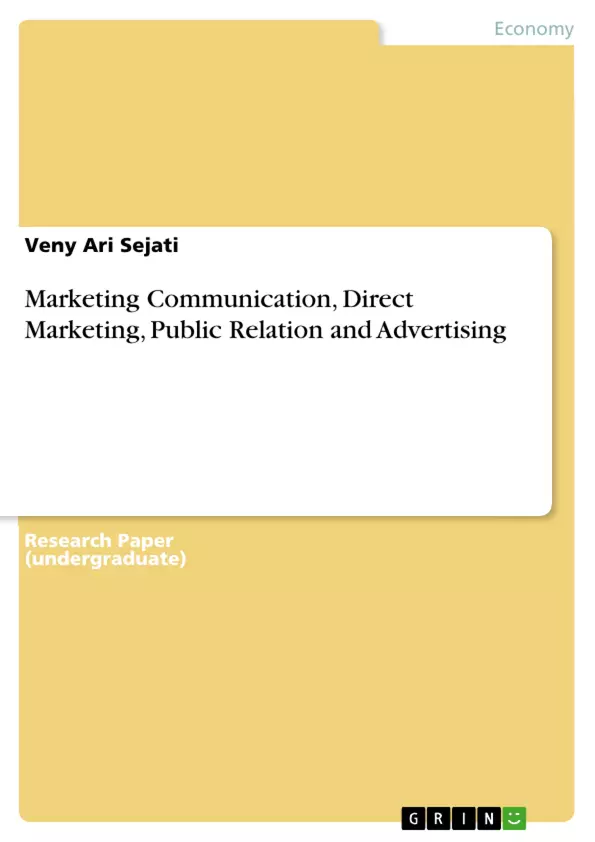Communication science exists in every area of life, including in marketing activities. Promotional activities, advertising, through communication media facilitate marketing activities to achieve the desired goals.
This book contains marketing communication lecture materials and will always be developed so that students can become business practitioners who have critical and advanced analysis. The main references in this book are Advertising written by Sandra Moriarty, et al, along with supporting references from various sources.
Inhaltsverzeichnis (Table of Contents)
- CHAPTER 1. COMMUNICATION
- A. Definition of Communication.
- B. Marketing Communications
- C. Interactive Communication Model.
- CHAPTER 2. MARKETING.
- A. What is Marketing?
- B. Main Marketing Concepts
- C. Basic Marketing plan.
- D. Marketing Mix Component.
- CHAPTER 3. DIRECT MARKETING (DM).
- A. Direct Marketing (DM)......
- B. Advantages and disadvantages of Direct Marketing...
- C. Direct Marketing Process...
- D. Direct Marketing Tools.
- E. The size of the Direct Response Evaluation
- CHAPTER 4. SALES PROMOTION, OTHER PROMOTION TYPES.
- A. Promotion vs. Advertising.
- B. Sales Promotion ..
- C. Cross-Border Promotion
- D. Evaluation of Sales Promotion
- CHAPTER 5. PUBLIC RELATION.
- A. Public Relation (PR).
- B. Comparison PR and Advertising...
- C. Type PR Program..
- D. PR Planning.
- E. PR Goals and Strategies
- F. PR Tools.
- G. PR Evaluation..
- CHAPTER 6. ADVERTISING
- A. Definition of Advertising.
- B. Roles and Type Advertising..
- CHAPTER 7. REVIEW MEDIA
- A. Media Basics.
- B. Print Media
- C. Broadcast Media
- D. Internet.
- E. Non-traditional Media
Zielsetzung und Themenschwerpunkte (Objectives and Key Themes)
This book aims to provide students with a comprehensive understanding of marketing communication and its application in business practices. It seeks to develop their critical and analytical skills, enabling them to become effective marketing practitioners.- The role of communication in marketing.
- The various components of the marketing mix.
- The effectiveness of different promotional strategies.
- The application of advertising and public relations.
- The evolution of media and its impact on marketing.
Zusammenfassung der Kapitel (Chapter Summaries)
- Chapter 1: Communication: This chapter explores the fundamental concepts of communication, emphasizing its importance in marketing. It delves into the definition of communication, marketing communications, and introduces an interactive communication model.
- Chapter 2: Marketing: This chapter lays the groundwork for understanding marketing, defining its core principles and concepts. It outlines the key components of a marketing plan and examines the elements of the marketing mix.
- Chapter 3: Direct Marketing (DM): This chapter focuses on direct marketing, exploring its advantages and disadvantages. It delves into the process of direct marketing and examines various direct marketing tools, including their effectiveness in achieving specific marketing goals.
- Chapter 4: Sales Promotion, Other Promotion Types: This chapter examines sales promotion, contrasting it with advertising. It explores various types of sales promotion techniques and explores the evaluation of their effectiveness in different marketing scenarios.
- Chapter 5: Public Relation: This chapter delves into the realm of public relations, outlining its definition and comparing it to advertising. It explores different types of public relations programs, analyzes PR planning, and examines the tools and strategies utilized in this field.
- Chapter 6: Advertising: This chapter defines advertising and examines its crucial roles in marketing. It further explores various types of advertising, outlining their strengths and applications in different contexts.
- Chapter 7: Review Media: This chapter delves into the world of media, exploring its fundamentals. It analyzes various media types, including print, broadcast, internet, and non-traditional media. It examines their effectiveness in reaching target audiences and achieving marketing objectives.
Schlüsselwörter (Keywords)
Marketing communication, advertising, public relations, sales promotion, direct marketing, media, marketing mix, communication model, business practices, promotion strategies, interactive communication.
Fin de l'extrait de 40 pages
- haut de page
- Citation du texte
- Veny Ari Sejati (Auteur), 2018, Marketing Communication, Direct Marketing, Public Relation and Advertising, Munich, GRIN Verlag, https://www.grin.com/document/428199
Lire l'ebook



